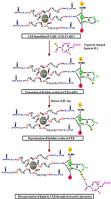Journal of Environmental Management ( IF 8.0 ) Pub Date : 2021-09-16 , DOI: 10.1016/j.jenvman.2021.113755 Maseed Uddin 1 , K V Swathi 1 , Ananya Anil 1 , R Boopathy 2 , K Ramani 1 , G Sekaran 3

|
Bioremediation of municipal landfill leachate (MLL) is often intricate due to presence of refractory lignin. In the present study, it was attempted to tailor the histidine rich protein moiety of cationic lipoprotein biosurfactant (CLB) to sequester the lignin from MLL. Animal fleshing (AF), the solid waste generated in tanning industry was utilized for the production of histidine rich CLB by de novo substrate dependent synthesis pathway involving Bacillus tropicus. The optimum conditions for the maximum production of CLB were determined using response surface methodology. At the optimized conditions, the maximum yield of CLB was 217.4 mg/g AF (on dry basis). The produced histidine rich CLB was purified using Immobilized metal affinity chromatography at the optimum binding and elution conditions. The histidine residues were more pronounced in the CLB, as determined by HPLC analysis. The CLB was further characterized by SDS-PAGE, Zeta potential, XRD, FT-IR, Raman, NMR, GC-MS and TG analyses. The CLB was immobilized onto functionalized nanoporous activated bio carbon (FNABC) and the optimum immobilization capacity was found to be 211.6 mg/g FNABC. The immobilization of CLB onto FNABC was confirmed using SEM, FT-IR, XRD and TG analyses. The isotherm models, kinetic and thermodynamics studies of CLB immobilization onto FNABC were performed to evaluate its field level application. Subsequently, the CLB-FNABC was then applied for the sequestration of lignin in MLL. The maximum lignin sequestration was achieved by 92.5 mg/g CLB-FNABC at the optimized sequestration time, 180 min; pH, 5; temperature, 45 °C and mass of CLB-FNABC, 1.0 g. The sequestration of lignin by CLB- FNABC was confirmed by SEM, FT-IR and UV–Vis analyses. Further, the mechanistic study revealed the anchoring of CLB onto the surface of lignin through electrostatic interaction.
中文翻译:

定制阳离子脂蛋白生物表面活性剂对城市垃圾渗滤液中木质素的生物隔离,通过热带芽孢杆菌增值制革厂固体废物
由于难降解木质素的存在,市政垃圾渗滤液 (MLL) 的生物修复通常很复杂。在本研究中,试图定制阳离子脂蛋白生物表面活性剂 (CLB) 的富含组氨酸的蛋白质部分,以隔离 MLL 中的木质素。动物肉(AF)是制革工业中产生的固体废物,通过涉及热带芽孢杆菌的从头底物依赖性合成途径用于生产富含组氨酸的CLB 。使用响应面方法确定了最大生产 CLB 的最佳条件。在优化条件下,CLB 的最大产量为 217.4 mg/g AF(干基)。使用固定化金属亲和层析在最佳结合和洗脱条件下纯化产生的富含组氨酸的 CLB。根据 HPLC 分析确定,CLB 中的组氨酸残基更为明显。通过 SDS-PAGE、Zeta 电位、XRD、FT-IR、拉曼、NMR、GC-MS 和 TG 分析进一步表征了 CLB。将 CLB 固定在功能化纳米多孔活性炭 (FNABC) 上,发现最佳固定容量为 211.6 mg/g FNABC。使用 SEM、FT-IR、XRD 和 TG 分析证实了 CLB 固定在 FNABC 上。等温线模型,进行了 CLB 固定在 FNABC 上的动力学和热力学研究,以评估其现场水平应用。随后,CLB-FNABC 被应用于 MLL 中木质素的螯合。92.5 mg/g CLB-FNABC 在优化的螯合时间 180 分钟实现了最大的木质素螯合;pH值,5;温度,45 °C,CLB-FNABC 质量,1.0 g。SEM、FT-IR 和 UV-Vis 分析证实了 CLB-FNABC 对木质素的螯合。此外,机理研究揭示了 CLB 通过静电相互作用锚定在木质素表面上。180 分钟;pH值,5;温度,45 °C,CLB-FNABC 质量,1.0 g。SEM、FT-IR 和 UV-Vis 分析证实了 CLB-FNABC 对木质素的螯合。此外,机理研究揭示了 CLB 通过静电相互作用锚定在木质素表面上。180 分钟;pH值,5;温度,45 °C,CLB-FNABC 质量,1.0 g。SEM、FT-IR 和 UV-Vis 分析证实了 CLB-FNABC 对木质素的螯合。此外,机理研究揭示了 CLB 通过静电相互作用锚定在木质素表面上。










































 京公网安备 11010802027423号
京公网安备 11010802027423号